
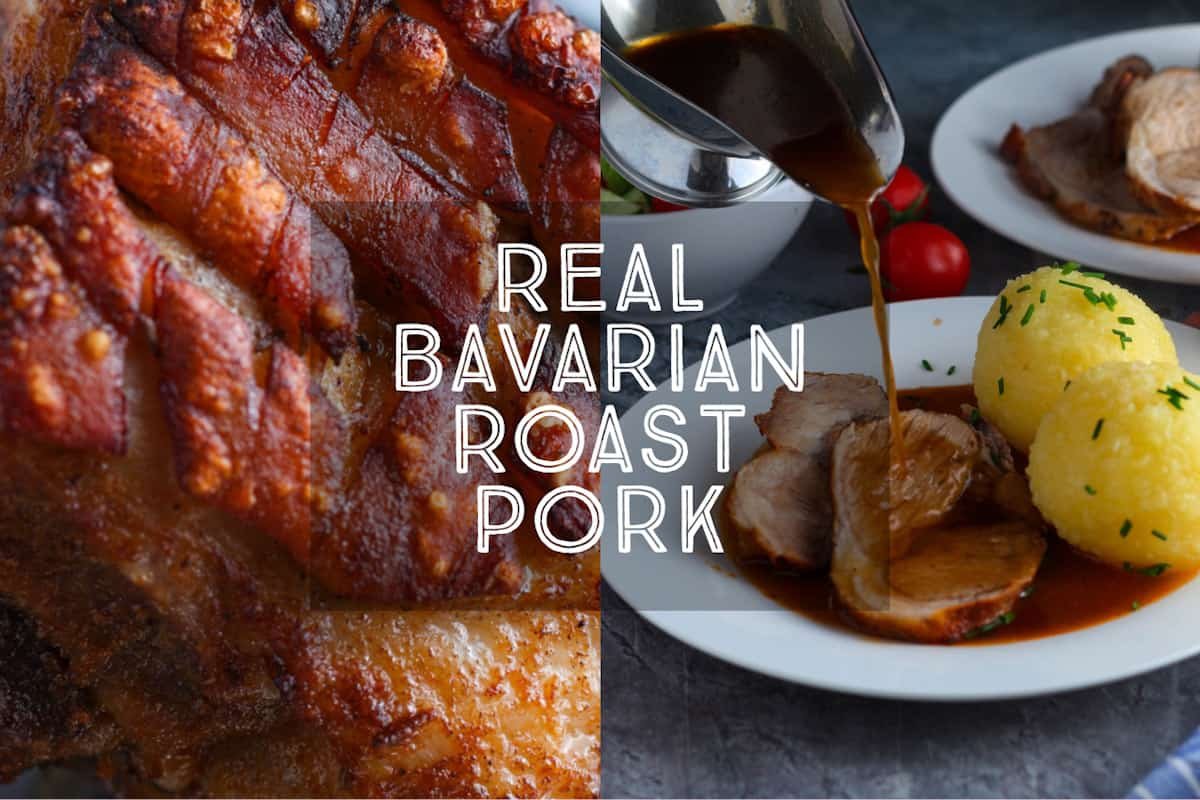
Bavarian Roast Pork – Krustenbraten
The ultimate Bavarian Sunday roast: Krustenbraten with Dunkelbiersoße. My classic recipe for crispy, juicy Bavarian roast pork with a lip-smackingly good dark beer sauce is always a winner and perfect for cooler weather.
There are no two ways about it, Bavarians love their pork, and right at the top of the recipe list has to be Krustenbraten or Bavarian Roast Pork.
With shatteringly crunchy crackling, juicy, tender meat, all smothered in a delicious dark beer sauce, this beloved dish is super popular in homes and restaurants across the land.
TABLE OF CONTENTS
▼
Is Bavarian Roast pork difficult to cook?
Not at all! A lot of people are scared of roasting meat, but once you have the technique, you’ll see it is a lovely easy meal to cook.
Traditionally this tasty roast is served with a dark beer sauce which mostly cooks in the oven at the same time as the meat, so it’s very hands-off.
Ingredients
To make the perfect Bavarian Roast Pork, you’l need the following main ingredients:
- Pork: Here in Bavaria, the pork shoulder is used to make this type of roast. This is a nicely marbled piece of meat with a good covering of fat (keeps the meat juicy) and skin which crisps up to perfect crackling in the oven.
- Carrots, Leek, Garlic and Celery Root: These vegetables roast alongside the pork and contribute to the richness and sweetness of the delicious dark beer sauce. Celery root can be swapped for celery stems or parsnip.
- Dark Beer: Bavaria is legendary for having some of the best beers in the world, so I like to use a delicious Dunkles Bier such as König Ludwig Dunkel (because I like to drink the beer that doesn’t go in the sauce!) You can use any good stout or dark beer that you have available locally with great results.
Cooking Times
The correct cooking time is so important when roasting meat, and is always a concern for new and experienced cooks alike.
I’ve included approximate cooking times for the pork in the recipe below, but I’d highly using recommend an instant read digital thermometer.
They are inexpensive, useful in loads of recipes and take ALL the guesswork out of cooking. There’s a link in the recipe card below.
Suggested Side Dishes
Traditionally, Bavarian Roast Pork is served with German potato dumplings (kartoffelknödel), but it is perfectly delicious with potato salad, mashed potatoes of just some good quality crusty bread.
It is also lovely served with cooked sauerkraut or or coleslaw (krautsalat) alongside.
Even in the warmer weather, we love a roast for Sunday lunch or dinner, with the aroma of a slow-cooked meal wafting through the house and making everyone hungry! You can check out some more of my favourite roasts by clicking here.
FREQUENTLY ASKED QUESTIONS
I can only get a different sized piece of pork – can I still cook Bavarian Roast Pork?
Yes! If you are cooking roast pork for a crowd the timings for larger pieces are in the recipe card and below. You need to make sure to add a bit more liquid as during the longer cooking time it will dry out.u003cbru003eu003cbru003eu003cstrongu003e1kg – 80 minutesu003cbru003e1.5kg – 120 minutesu003cbru003e2kg – 160 minutesu003cbru003e2.5kg – 200 minutesu003c/strongu003e
How do I reheat roast pork?
It is particularly tasty to gently reheat slices of pork in the leftover gravy. That way it stays perfectly juicy and gets loads of extra flavour. Otherwise, cover it with tinfoil and reheat it in a low oven.
At what temperature is roast pork done?
Ahh, my favourite topic. Pork can now officially be cooked to medium-rare (hurrah!) which means that the bad old days of dried out, tough-as-leather-pork are officially over. The guidance from u003ca href=u0022https://www.pork.org/pork-cooking-temperature/u0022 target=u0022_blanku0022 rel=u0022noreferrer noopeneru0022u003ethose in the knowu003c/au003e is that pork can be cooked to a temperature of 63°C / 145°F for medium-rare which I think is perfect for lean cuts like a tenderloin. For pork shoulder, I like to cook it a little hotter, up to 70°C / 160°F.
Can pork roast be slightly pink?
Yes! As above, Pork can now be cooked medium rare according to official guidelines. Enjoy!
Should I brine this pork roast?
You can brine any meat you like, though I find it doesn’t add anything to this particular recipe as there is a good layer of skin and fat to keep the meat from drying out.
Should i sear thr pork at a low or high heat?
Browning the meat before roasting (known as the Maillard reaction) adds flavour helps keep the meat moist and juicy. Unlike a steak which is often seared hard and fast, I like to sear pork roast over a lower heat to gently brown the outside. In this recipe a lower heat is better.
Bavarian Roast Pork – Krustenbraten
The ultimate Bavarian Sunday roast: Krustenbraten with Dunkelbiersoße. My classic recipe for crispy, juicy Bavarian roast pork with a lip-smackingly good dark beer sauce is always a winner and perfect all year roundr.
Ingredients
- 1 kg pork shoulder, with skin
- 2 tsp sea salt
- 2 tsp sweet paprika powder
- 1 tsp ground black pepper
- 2 Tbsp neutral oil, e.g. sunflower
- 1 Tbsp butter
- 2 carrots, diced
- 1 leek, chopped,
- ¼ head of celeriac or 2 celery sticks, diced
- 4 cloves garlic, chopped
- 1 tsp caraway seeds
- 250 ml vegetable stock
- 250 ml dark beer
- 2 tsp tomato paste
- 1 tsp sugar
optional:
- 1 Tbsp cornstarch / cornflour
Instructions
- PREPARE: Heat the oven to 180°C / 350°F / Gas 4. Use a very sharp knife (a box cutter is excellent for this) to score the skin of the pork in a diamond pattern. Rub the pork generously with the salt, paprika and pepper then set aside.
- SEAR THE MEAT: In an oven-proof pan or casserole, heat the oil and butter over a medium heat until the butter has melted and is foaming. Brown the pork on all sides, cooking 2-3 minutes per side without moving. Browning the meat with butter over a medium heat will prevent the paprika from burning. Remove the pork from the pan and set aside in a bowl to catch any juices..
- COOK THE VEGETABLES: Add the carrots, leek, celeriac or celery, garlic and caraway seeds to the pan and cook gently for 5 minutes, until beginning to soften. Pour in the vegetable stock to deglaze the pan, using a wooden spatula to scrape up all the browned on flavour.
- ROAST THE PORK: Return the pork to the pan skin side down. Roast in the preheated oven for 30 minutes, then turn the meat skin side up and pour the beer into the pan. Roast a further 50 minutes to 1 hour, until the meat is cooked through. It should register 70°C / approx. 160°F on a meat thermometer.
- MAKE THE GRAVY: When the meat has cooked, remove it from the oven and turn the broiler/grill to high. Place the pork in an ovenproof dish, then pour the roasting juices through a sieve into a small saucepan, pressing down on the vegetables to extract all the juices.
- SEASON AND THICKEN THE GRAVY: Stir in the tomato paste and sugar and bring to a simmer. Taste and adjust seasoning as necessary If you’d like to thicken the dark beer sauce, stir the cornstarch into a little bit of cold water until smooth, then add to the pan, stirring until thickened. Keep warm.
- CRISP THE PORK SKIN: To crisp the skin of the pork, return the pork to the middle of the oven. Keep a good eye on it as the skin will begin to crackle and pop very quickly. When it has reached the desired crispness (5-7 minutes), remove it from the oven.
- SERVE: Slice the pork and serve on warmed plates. Traditionally Krustenbraten is served with potato dumplings (Knödel) but it is also delicious with mashed potato.
Notes
ROASTING TIMES:
I’ve given the timing in this recipe for a 1kg piece of meat which should easily feed four people with sides. Below are the roasting times for larger pieces of meat. Whichever way you cook it, don’t add the beer to the roasting pan until at least halfway through cooking time – you may find you need a little more liquid as it will evaporate during the cooking process.
1kg / 2 lb. = 80 minutes
1.5kg / 3.25 lb. = 120 minutes
2kg / 4.5 lb = 160 minutes
2.5kg / 5.5 lb. = 200 minutes
1.5kg / 3.25 lb. = 120 minutes
2kg / 4.5 lb = 160 minutes
2.5kg / 5.5 lb. = 200 minutes
As an Amazon Associate and member of other affiliate programs, I earn from qualifying purchases.
Nutrition
Serving: 3 slices | Calories: 411kcal | Carbohydrates: 18g | Protein: 32g | Fat: 21g | Saturated Fat: 6g | Polyunsaturated Fat: 2g | Monounsaturated Fat: 12g | Trans Fat: 0.1g | Cholesterol: 110mg | Sodium: 1661mg | Potassium: 877mg | Fiber: 3g | Sugar: 5g | Vitamin A: 6247IU | Vitamin C: 11mg | Calcium: 81mg | Iron: 3mg
Tried this recipe?I’d love to hear how it went! Please leave a review or a star rating and let me know how it was! Use the hashtag #daysofjay on Instagram so I can see your delicious creations.

About the Author
Jay Wadams is a cookbook author, food photographer, and graduate of Le Cordon Bleu in Gastronomy and Nutrition.
Based in Italy 🇮🇹 Germany 🇩🇪 and Australia 🇦🇺.


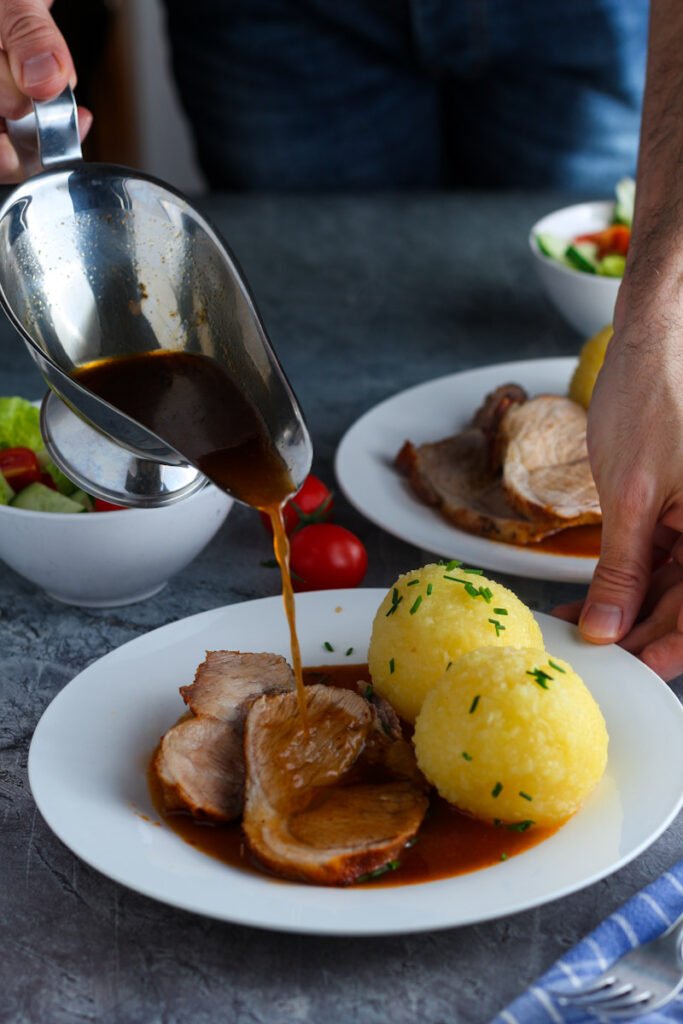
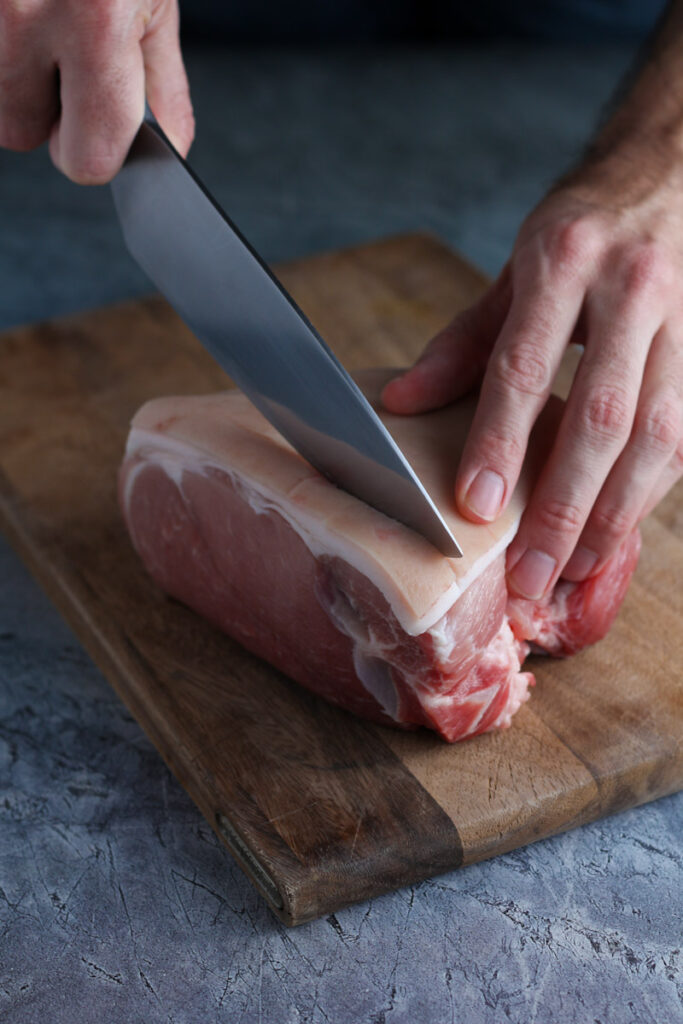
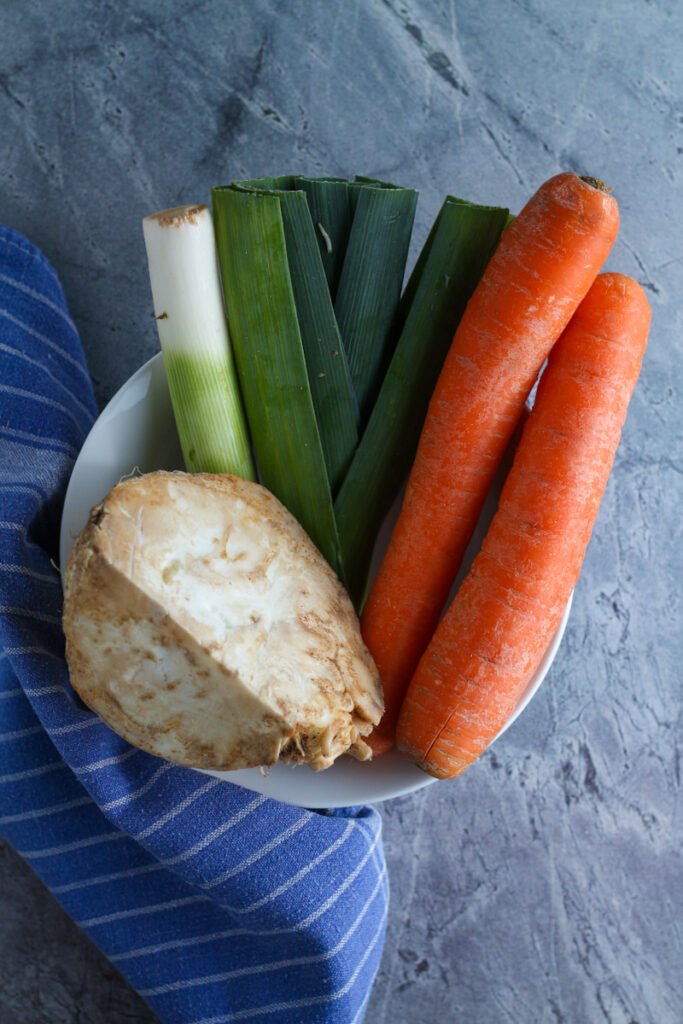
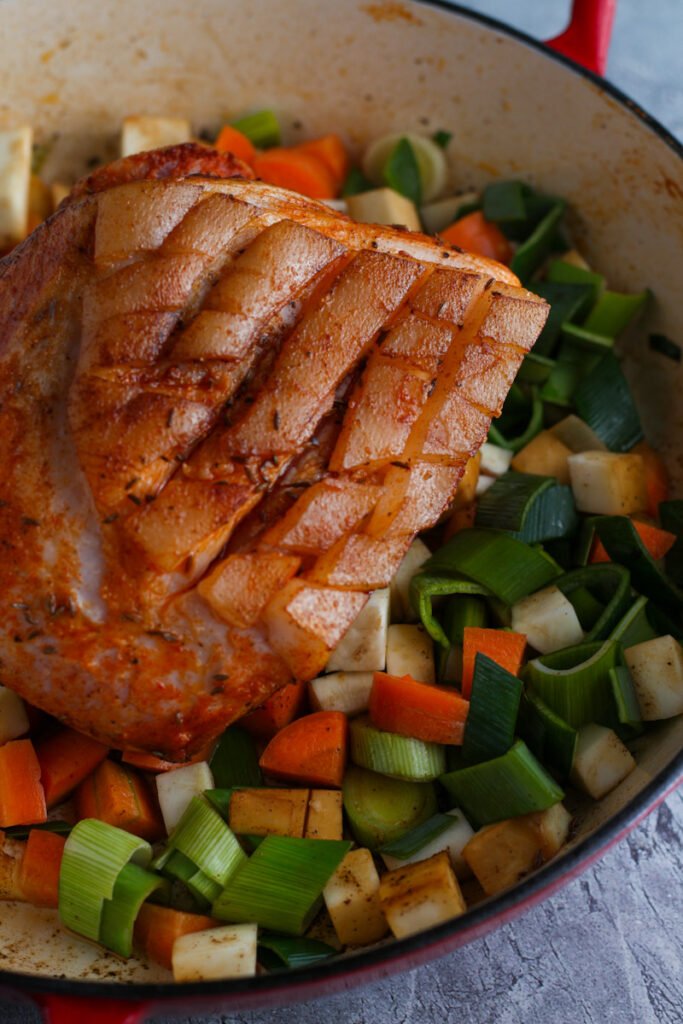
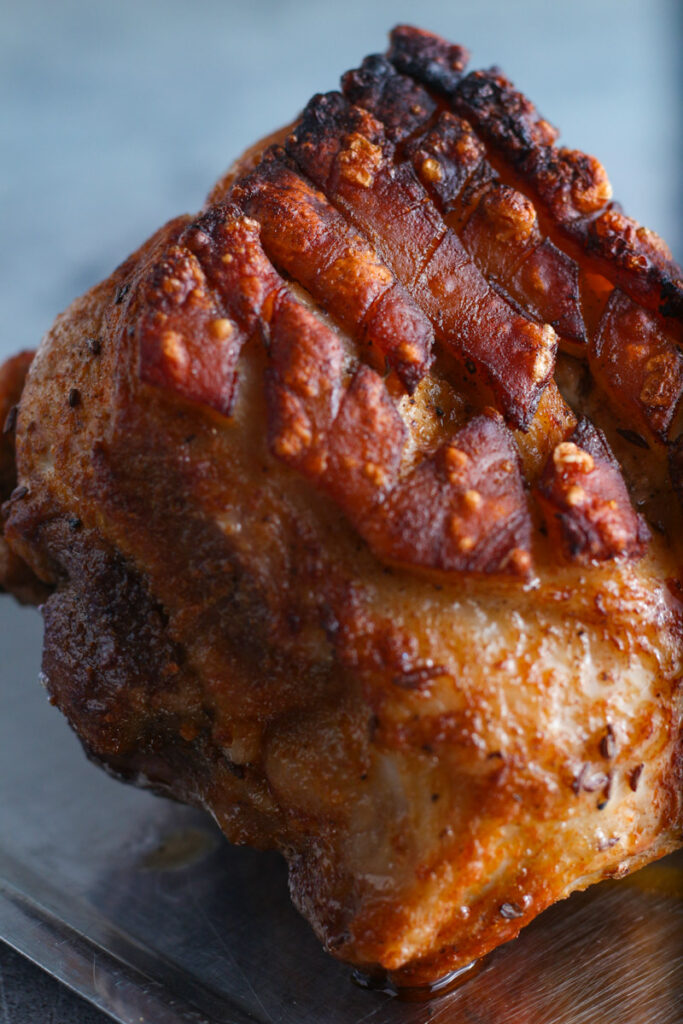

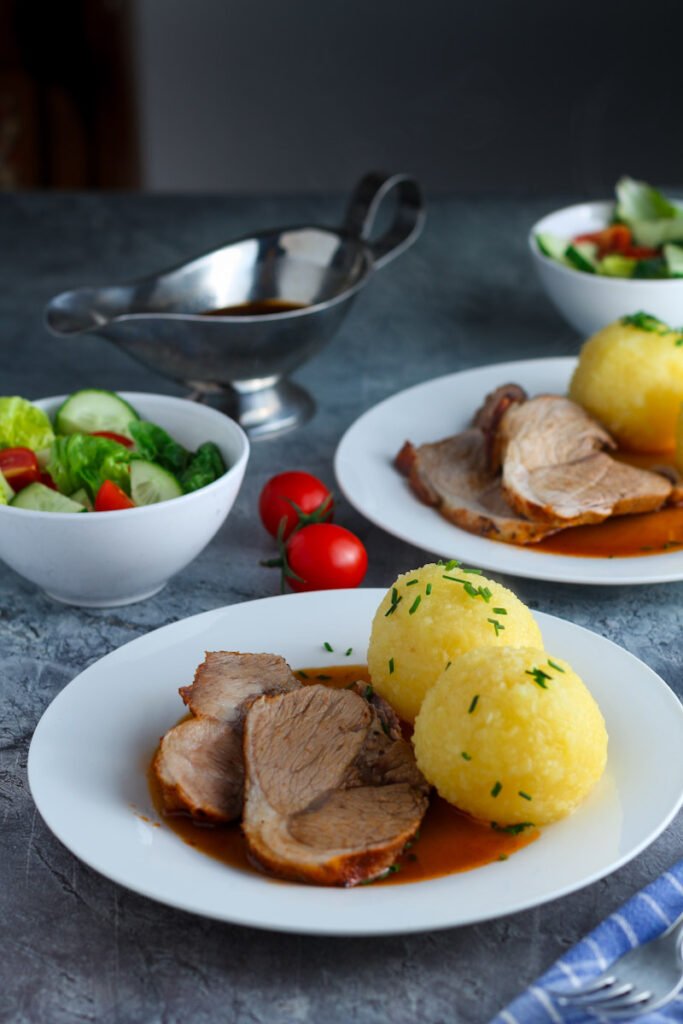
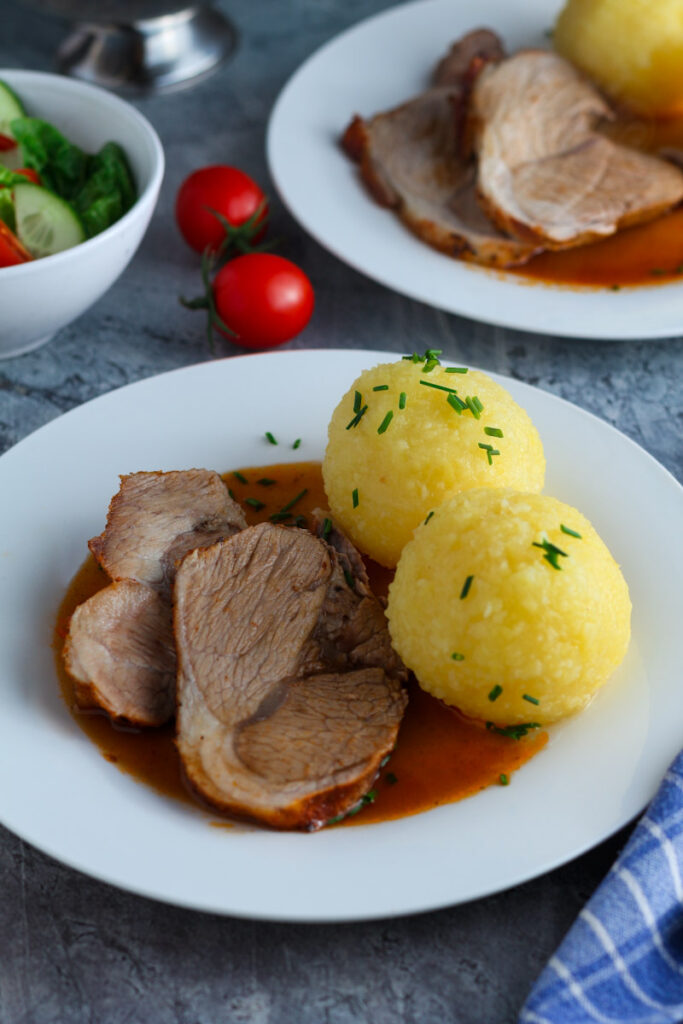


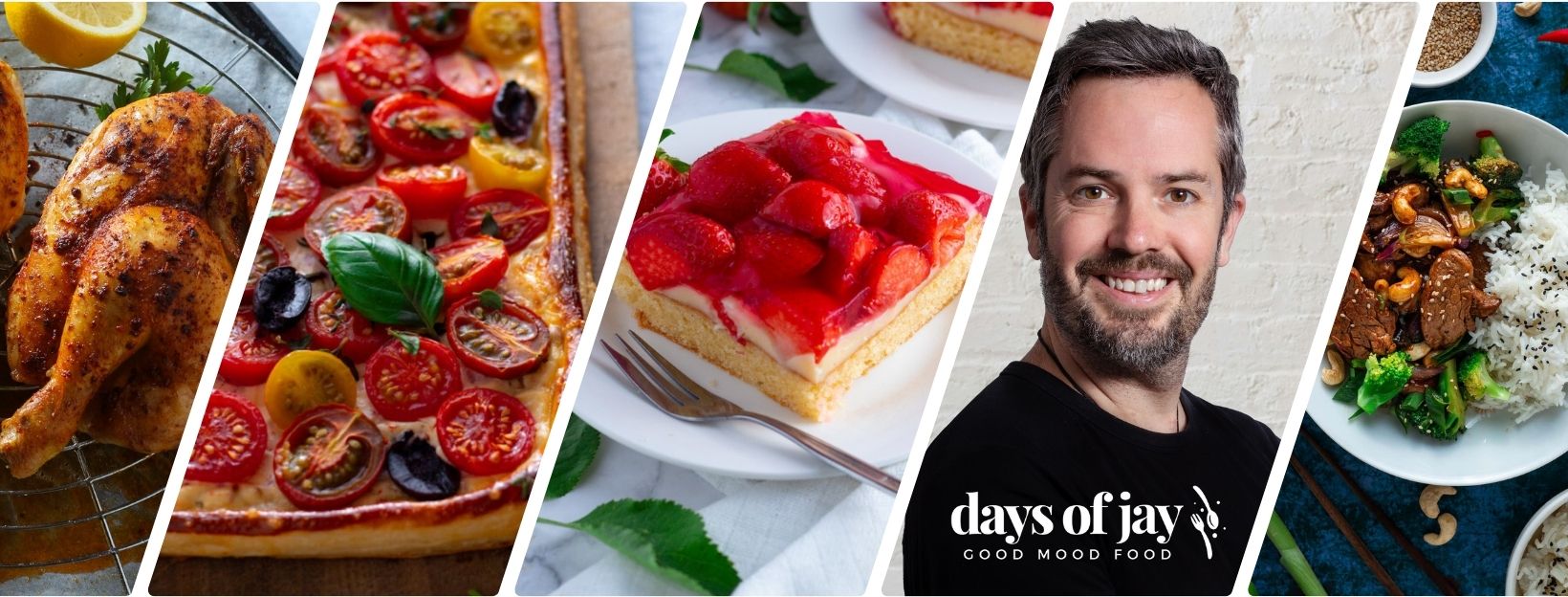
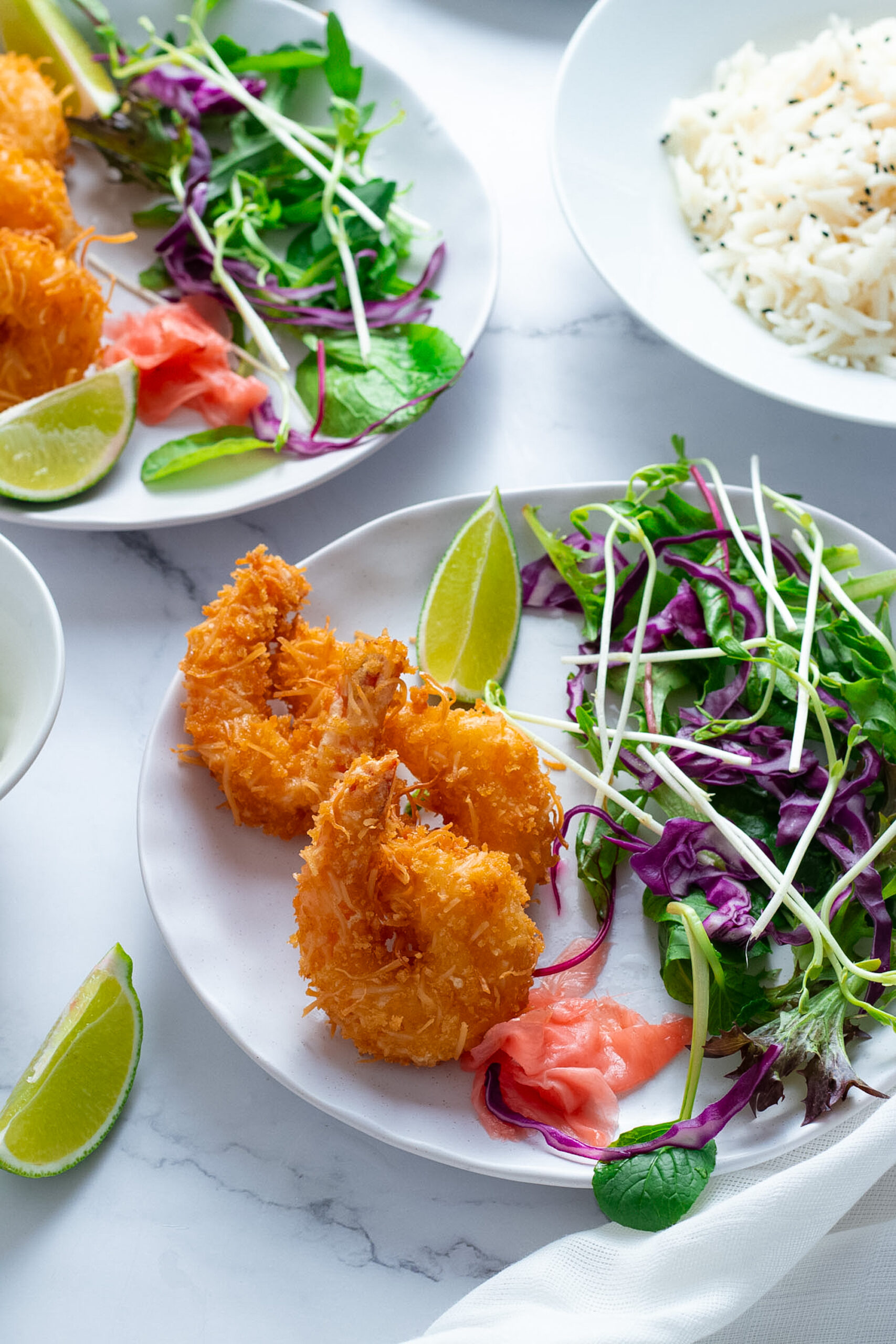
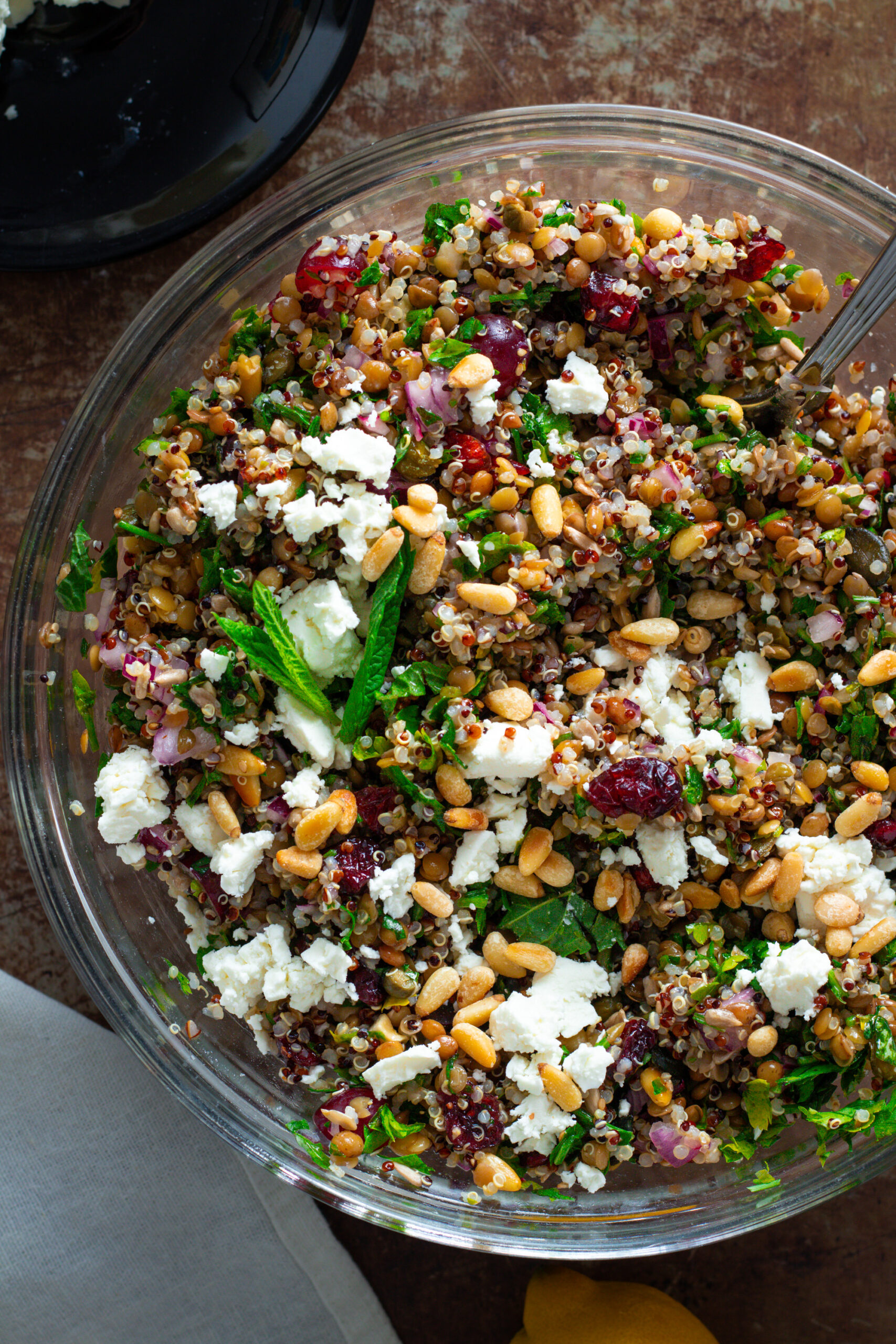
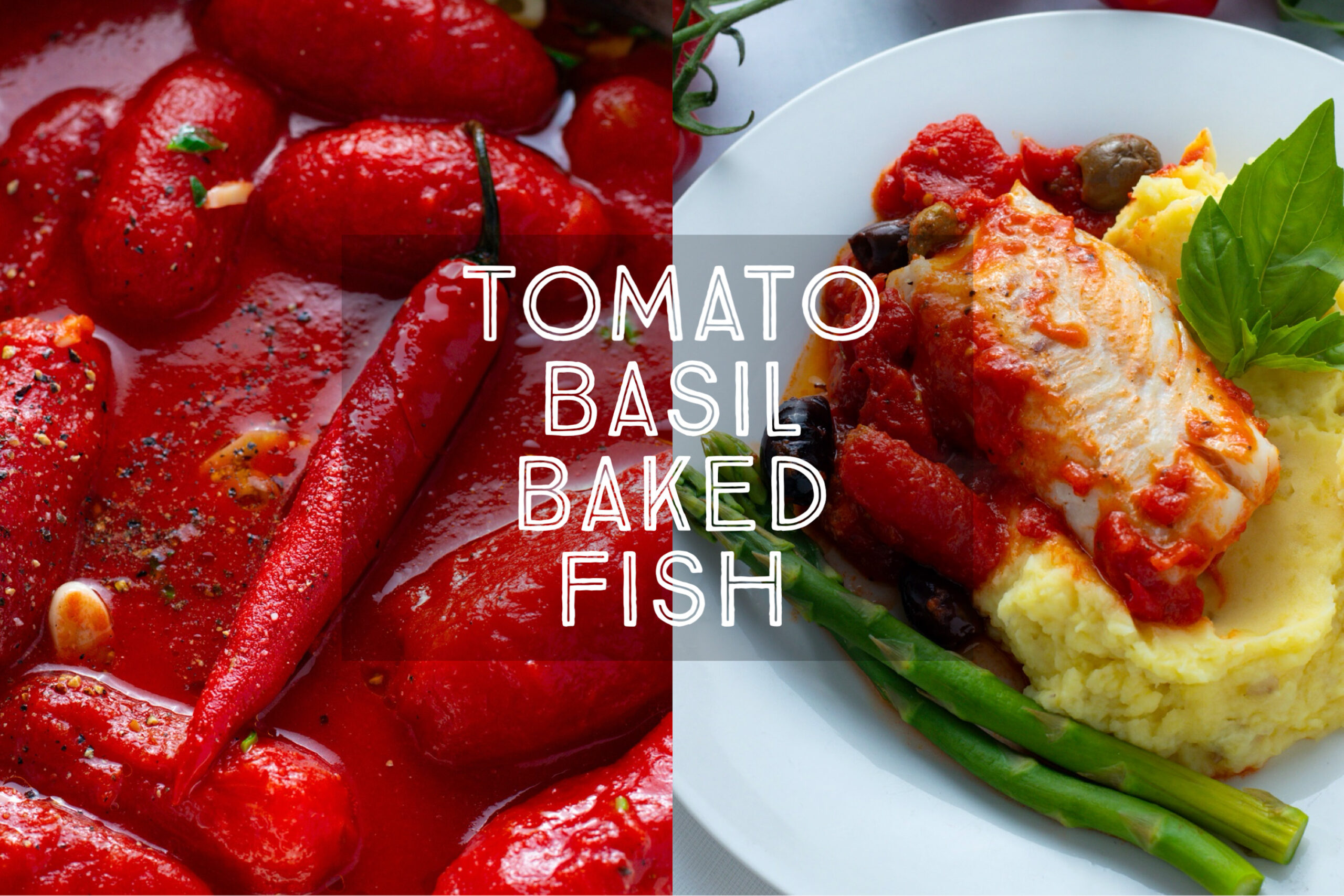
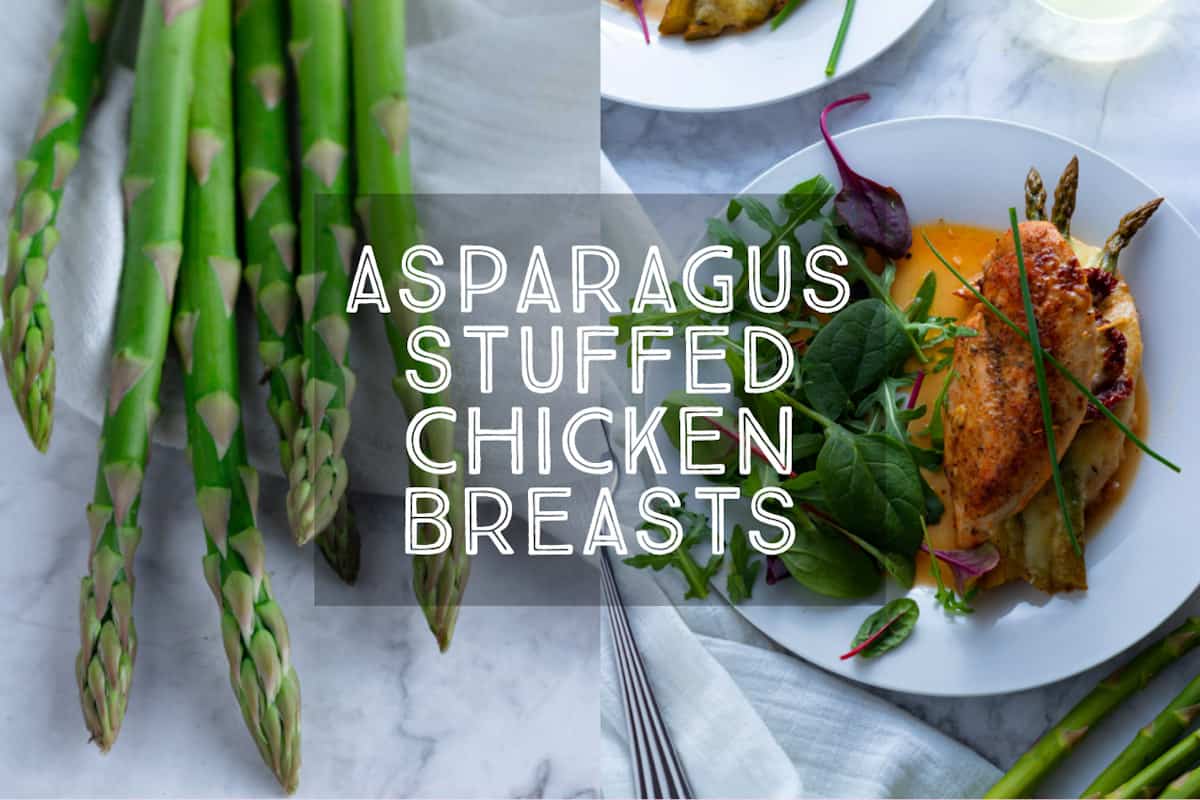
The meat overall cooked great and the beer sauce was phenomenal!! But, I had struggled to keep the crust just right in coloration. I think the paprika spice contributed to this, as I was searing all sides at the beginning. The heat setting was usual, but it seemed to have burned quickly. I’m wondering how I could avoid this in the future.
Had troubles with the crust but a great recipe!
The meat overall cooked great and the beer sauce was phenomenal!! But, I had struggled to keep the crust just right in coloration. I think the paprika spice contributed to this, as I was searing all sides at the beginning. The heat setting was usual, but it seemed to have burned quickly. I’m wondering how I could avoid this in the future.
Hi Kaori! Thank you so much for your kind words and your fantastic question! You’ve really helped me clarify something in this recipe and I’ve updated it so that it is clearer. For a meat like this with a dry rub on it I brown or sear the meat at a lower temperature to stop burning, it’s tempting to get the pan screaming hot like you might do with steak but the browning reaction actually starts at temps as low as 150°C / 350°F! Adding a little butter to the pan and browning over a medium heat will help prevent burning as you can really see how hot the pan is.
If you are finding that the top crust gets too dark in the oven you can either turn the meat later in the cooking process or cover it with a little square of foil until near the end of the cooking time.
Thank you so much again for your brilliant question! J.
Top marks for me. Hah. A well thought out recipe…very informative. Ta.
–
–
Thanks so much Frank! I am so happy you enjoyed this recipe! Jay